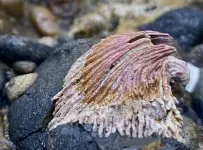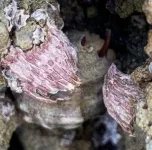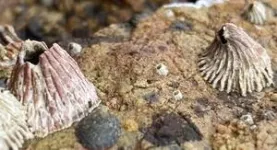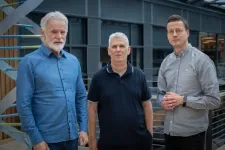(Press-News.org) Some barnacles are ‘morphing’ to protect themselves from predatory warm-water sea snails, which are expanding into their territory due to climate change.
Research led by the University of Southampton and published in the Journal of Biogeography shows how temperate prey species are adapting to changing water temperatures, which carry the threat of warm-water predators encroaching into their territory.
As global sea-surface temperatures rise and the number of marine heatwaves increase under global heating, coastal marine communities are changing. Warm-water predators that were restricted to subtropical and tropical regions are now establishing themselves in more temperate waters. This phenomenon is known as ‘tropicalisation’.
As these predators push out from the equator towards the poles, temperate prey species, like the barnacle Tetraclita rubescens, are encountering new, larger, predators. Researchers wanted to know how this barnacle species might adapt their defences in response to tropicalisation.
Specifically, they studied the prevalence of ‘bent morphs’ – individual barnacles that morph into a bent shape, obscuring an opening in their shells which can be attacked by predatory sea snails (muricids). Bent morphs have slower growth and lower reproduction than the standard cone-shaped barnacles, but this could be a necessary trade-off in the face of increased predation.
“We found that bent morphs of T. rubescens were more common in the most southern part of its geographic range in the Baja California peninsula of Mexico, which is a region undergoing tropicalisation,” says Dr Phillip Fenberg, Associate Professor in Ocean and Earth Science at the University of Southampton and lead author of the research. “In these waters, T. rubescens barnacles are preyed upon by at least three species of warm-water sea snails which are expanding their geographic range due to rising sea temperatures. These sea snails have large bodies, and some can secrete toxins, making them very effective predators.”
The research team studied 30 sites along the Pacific coast of North America - examining over a thousand photographs taken between 2017 and 2022. Using these photographs, they determined the prevalence of bent morphs, as well as their relative size compared to conic morphs. The team also used published research and field surveys to find out how barnacle populations overlap with the range expansion of warm-water predatory sea snails.
Bent morphs were only common along the Baja peninsula of Mexico, where tropicalisation is occurring. Here, they made up an average of 29% of the populations. Bent morphs were also significantly smaller than cone-shaped barnacles.
In regions further away (in California, USA), bent morphs were absent, suggesting cold-water predatory sea snails don’t induce the same morphing defence.
Karolina Zarzyczny, a co-author of the paper also from the University of Southampton, explains there could be several reasons for this: “The bent morph defence might be unnecessary, ineffective or not possible for barnacles in the cooler regions of its geographic range in California. We know that T. rubescens are preyed upon by cold-water sea snails, but these snails are smaller than their warm-water relatives and might prefer to prey on other barnacle species which pose less of a challenge.
“The bent shape could also be a less effective defence against cold-water predators, who attack their prey differently. Finally, more northerly populations in California may not have the genetic capacity to produce bent morphs, but this has yet to be determined.”
The research shows that some species may adapt in surprising ways to tropicalisation, which is likely to have a significant impact on marine ecosystems, on top of the direct consequences of warming sea temperatures. The researchers say more research is needed to understand the drivers and consequences of tropicalisation on marine ecosystems.
Predator-induced defences under tropicalisation: A biogeographic approach is published in the Journal of Biogeography and is available online.
The research was funded by The Royal Society, the Natural Environment Research Council (NERC), the Malacological Society of London, the Genetics Society and the Multi-Agency Rocky Intertidal Network (MARINe).
Ends
Contact
Steve Williams, Media Relations, University of Southampton press@soton.ac.uk or 023 8059 3212.
Notes for editors
“Predator-induced defences under tropicalisation: A biogeographic approach” is published in the Journal of Biogeography and is available here: https://onlinelibrary.wiley.com/doi/10.1111/jbi.14716
For Interviews with Dr Phillip Fenberg, Associate Professor in Ocean and Earth Science at the University of Southampton, please contact Steve Williams, Media Relations, University of Southampton press@soton.ac.uk or 023 8059 3212.
Images available here: https://safesend.soton.ac.uk/pickup?claimID=ep4Ybsawm3xgt3Zd&claimPasscode=pp7Zje9bYfqwX2cR
Bent morph 1 – Bent morph T. rubescens barnacle
Bent morph 2 – Two bent morphs with warm water predatory snail (Mexacanthina lugubris) in the background
Bent morph 3 - Bent morph T. rubescens barnacle
Conic and bent morph – Conic morph (left) and bent morph (right)
Group of bent morphs – Group of bent morphs on rock face
Plicopurpura columellaris – Warm water Plicopurpura columellaris sea snail next to T. rubescens barnacles
Stramonita_biserialis – Warm water Stramonita biserialis is larger than more northerly sea snails
Mexacanthina_lugubris - Warm water sea snail Mexacanthina lugubris
Please credit all images: University of Southampton
Additional information
The University of Southampton drives original thinking, turns knowledge into action and impact, and creates solutions to the world’s challenges. We are among the top 100 institutions globally (QS World University Rankings 2023). Our academics are leaders in their fields, forging links with high-profile international businesses and organisations, and inspiring a 22,000-strong community of exceptional students, from over 135 countries worldwide. Through our high-quality education, the University helps students on a journey of discovery to realise their potential and join our global network of over 200,000 alumni. www.southampton.ac.uk
www.southampton.ac.uk/news/contact-press-team.page
Follow us on X: https://twitter.com/UoSMedia
END
Barnacle bends shape to fend off warm-water sea snails on the move
Research shows changing predator-prey dynamics as sea temperatures rise
2023-11-09
ELSE PRESS RELEASES FROM THIS DATE:
AI can map giant icebergs from satellite images 10,000 times faster than humans
2023-11-09
AI can map giant icebergs from satellite images 10,000 times faster than humans
Scientists have trained an artificial intelligence (AI) system to accurately map - in one-hundredth of a second - the surface area and outline of giant icebergs captured on satellite images.
It is a major advance on existing automated systems which struggle to distinguish icebergs from other features in the image. Manual - or human - interpretation of the image is more ...
People who contribute least in crowdsourcing can do the most to improve a public good
2023-11-08
Whether talking about the office kitchen, hiking trails or ratings on Yelp, there are always people who put in effort to leave those spaces better. There are also those who contribute nothing to that public good.
New research using large-scale online experiments suggests that rewarding people to contribute to a virtual public good, such as a simulated online rating for a ferry system, increased the accuracy of the ratings and improved the overall quality of that resource.
The multidisciplinary team, including researchers from the University of California, Davis; Hunter College, College of New York; the Max Planck Institute for ...
1 in 25 carries a genotype that is associated with a shortened lifespan
2023-11-08
1 in 25 carries a genotype that is associated with a shortened lifespan
Scientists at deCODE genetics, a subsidiary of Amgen, have published a study on actionable genotypes detected in the Icelandic population and their association with lifespan. The results of this study are among the things that have motivated the government of Iceland to announce a nationwide effort in precision medicine. As the delivery of precision medicine to a population requires considerable amount of data on genomics, transcriptomics and proteomics of the population, Icelanders are currently exceptionally well suited for ...
Zen and the art of mitochondrial maintenance: The machinery of death makes a healthier life
2023-11-08
While we all aspire for a long lifespan, what is most coveted is a long period of vigor and health, or “healthspan,” that precedes the inevitable decline of advancing age. Researchers at UC Santa Barbara have discovered that instruments of death that cells use to commit suicide when things go wrong contribute to making a longer and healthier life by revitalizing the specialized cellular compartments called mitochondria.
Mitochondria generate the energy for all of our activities, from movement to thought. These power plants inside our cells descended ...
MPFI researcher awarded $1.2 Million from Chan Zuckerberg Initiative
2023-11-08
Dr. Vidhya Rangaraju has been named a recipient of the Chan Zuckerberg Initiative’s “Ben Barres Early Career Acceleration Award,” which will provide her lab with $1.2 million over four years to study dysfunctions of brain energy supply.
Dr. Rangaraju is a Research Group Leader at the Max Planck Florida Institute for Neuroscience (MPFI). With this award, her lab will investigate the causes of disrupted energy supply in neurons that lead to cognitive decline in amyotrophic lateral sclerosis (ALS). ...
With new grant, RPI works to shrink microchips, expand semiconductor workforce
2023-11-08
Transistors — the tiny on-off switches inside microchips — have gotten smaller and smaller over the years, increasing computing power and enabling smaller devices. During that time, the copper wires that connect these switches have likewise shrunk.
However, smaller, thinner wires create a big problem, said Daniel Gall, professor of materials science and engineering at Rensselaer Polytechnic Institute.
“The job of the wire is to conduct electrons — electricity. Imagine a wire as a crowded hallway that the electrons have to get through. The narrower the hallway, the more the electrons bump into things and scatter. We call that resistance,” Gall ...
Single gene controls Corn Belt weed's resistance to soil-applied herbicide
2023-11-08
URBANA, Ill. — Waterhemp, the aggressive weed threatening Corn Belt crop production, is throwing curveballs once again, according to researchers at the University of Illinois Urbana-Champaign. The weed has famously developed resistance to not one or two, but seven herbicide sites-of-action classes, nearly exhausting the chemical tools farmers can use to defend their livelihood.
In a new Weed Science study, U. of I. researchers show that a single major gene is responsible for waterhemp’s resistance to S-metolachlor ...
Your education and income level may affect your survival, recovery from stroke
2023-11-08
EMBARGOED FOR RELEASE UNTIL 4 P.M. ET, WEDNESDAY, NOVEMBER 8, 2023
MINNEAPOLIS – People with low education and income levels may have a 10% increased risk of death or being dependent on others to complete daily tasks three months after a stroke compared to people with high education and income levels, according to new research published in the November 8, 2023, online issue of Neurology®, the medical journal of the American Academy of Neurology. The study does not prove that low education and income cause worse outcomes after stroke. It only shows an association.
“Compared ...
For epilepsy, yoga may be good for your mind
2023-11-08
EMBARGOED FOR RELEASE UNTIL 4 P.M. ET, WEDNESDAY, NOVEMBER 8, 2023
MINNEAPOLIS – For people with epilepsy, doing yoga may help reduce feelings of stigma about the disease along with reducing seizure frequency and anxiety, according to new research published in the November 8, 2023, online issue of Neurology®, the medical journal of the American Academy of Neurology.
“People with epilepsy often face stigma that can cause them to feel different than others due to their own health condition and that can have a significant impact on their quality of life,” said study author ...
Increasing workplace flexibility associated with lower risk of cardiovascular disease
2023-11-08
Embargoed for release: Wednesday, November 8, 4:00 PM ET
Key points:
In a randomized trial of the cardiometabolic impacts of workplace interventions designed to reduce work-family conflict, older employees and those at baseline higher risk for cardiometabolic disease saw their risk of developing cardiovascular disease decrease equivalent to five to 10 years of age-related cardiometabolic changes.
The study is among the first to assess whether changes to the work environment can affect cardiometabolic risk.
Boston, MA—Increasing workplace flexibility may lower employees’ risk of cardiovascular disease, according to a new ...
LAST 30 PRESS RELEASES:
Revealing the diversity of olfactory receptors in hagfish and its implications for early vertebrate evolution
Development of an ultrasonic sensor capable of cuffless, non-invasive blood pressure measurement
Longer treatment with medications for opioid use disorder is associated with greater probability of survival
Strategy over morality can help conservation campaigns reduce ivory demand, research shows
Rising temperatures reshape microbial carbon cycling during animal carcass decomposition in water
Achieving ultra-low-power explosive jumps via locust bio-hybrid muscle actuators
Plant-derived phenolic acids revive the power of tetracycline against drug-resistant bacteria
Cooperation: A costly affair in bacterial social behaviour?
Viruses in wastewater: Silent drivers of pollution removal and antibiotic resistance
Sub-iethal water disinfection may accelerate the spread of antibiotic resistance
Three in four new Australian moms struggle with body image
Post-stroke injection protects the brain in preclinical study
Cardiovascular risk score predicts multiple eye diseases
Health: estimated one in ten British adults used or interested in GLP-1 medications for weight loss
Exercise to treat depression yields similar results to therapy
Whooping cough vaccination for pregnant women strengthens babies’ immune system
Dramatic decline in new cases of orphanhood in Uganda driven by HIV treatment and prevention programs
Stopping weight loss drugs linked to weight regain and reversal of heart health markers
Higher intake of food preservatives linked to increased cancer risk
Mass General Brigham–developed cholera vaccine completes phase 1 trial
First experimental validation of a “150-year-old chemical common sense” direct visualization of the molecular structural changes in the ultrafast anthracene [4+4] photocycloaddition reaction
Lack of support for people on weight loss drugs leaves them vulnerable to nutritional deficiencies, say experts
Dogs’ dinners can have greater climate impact than owners’
Are you ready to swap salmon for sprats and sardines?
1.6 million UK adults used weight loss drugs in past year
American College of Cardiology comments on new dietary guidelines for Americans
American Society of Gene & Cell Therapy and Orphan Therapeutics Accelerator partner to advance and commercialize promising rare disease treatments
One in 14 patients having day case surgery have new or worse chronic pain 3 months after their operation
New study highlights link between eviction rates and gun violence
Heatwaves heat up soil but not toxin levels in rice, study finds
[Press-News.org] Barnacle bends shape to fend off warm-water sea snails on the moveResearch shows changing predator-prey dynamics as sea temperatures rise






